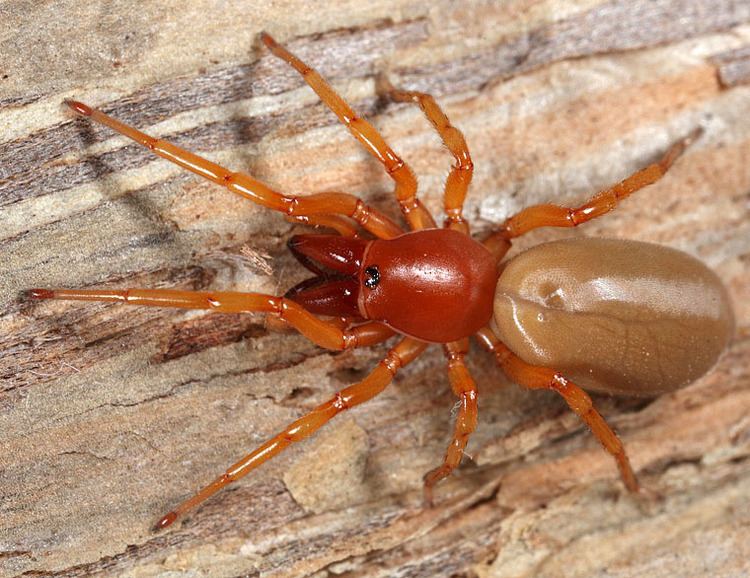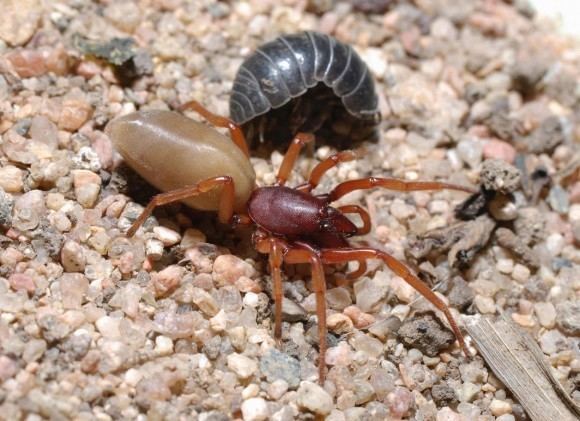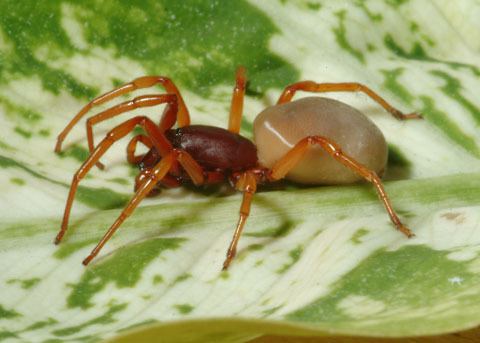Higher classification Dysderidae Rank Genus | Scientific name Dysdera Order Spider | |
 | ||
Similar Woodlouse spider, Dysderidae, Dysdera erythrina, Harpactea, Arachnid | ||
Meet the woodlouse spider dysdera crocata british spiders
Dysdera is a genus of spiders from the family Dysderidae. They originated from Central Asia to Central Europe.
Contents
- Meet the woodlouse spider dysdera crocata british spiders
- The woodlouse spider dysdera crocata in hd 1080p
- Distribution
- Shelter
- Description
- Behavior
- Diet
- Radiation in the Canary Islands
- References
The woodlouse spider dysdera crocata in hd 1080p
Distribution

Dysdera crocata, Dysdera ninnii, Dysdera dubrovninnii, Dysdera hungarica and Dysdera longirostris are the five species still found in Central Europe after the last glacial period. They are also abundantly found in North African countries like Morocco and Egypt, but also in Ethiopia, the Iberian Peninsula and Australia. Some species are found in the U.S., Dysdera crocata is found from New England down to Georgia and all the way across the country in California. However, at least two species inhabit South America (Dysdera solers in Colombia, (possibly a relict species from the post-miocene era) and Dysdera magna in Brazil and Uruguay, they are also very common in the central area of Chile). While Dysdera inhabits all of the Macaronesian archipelagos, the most drastic change from strictly the Canary Islands. Researches have discovered around 50 species just on the Canary Islands, six of those 50 are associated with the oldest eastern island. The spider population are limited to the highest elevation on Lanzarote and Fuerteventura islands. The most likely reason why Dysdera are abundantly found on the Canary Islands is due to 27 species found on the close shores of the Iberian Peninsula and North Africa. Groups like Dysdera crocata and Dysdera erythrina found on the two neighboring lands are found more often than Dysdera lata and Dysdera longirostis, which are also found in North Africa and Iberia. This family of spiders from there separate species have many common names; European garden spider, slater-eating spider, sow-bug killer, woodlouse hunter, and woodlouse spider.
Shelter

Dysdera are unable to produce webs for shelter causing them to be limited to the ground and natural shelters. Dysdera inhabit hot humid forest, or potentially any shelter on and close to the ground. They search for objects to hide under not only because they are ground dwellers but due to the moist earth's footing and keeping the spider warm. Dysdera shelter under objects like gravel with organic material covering it, stones, bark, also sometimes found in suburban gardens, anything to keep them protected from predators during the day. Dysdera unguimannis is considered the most remarkable case of troglomorphism (adaptation to cave life) in the Dysdera genus. They shelter under or in anything they can find but, only during the day due to strictly hunting prey at night.
Description

These spiders can be up to 2 cm long, Females are, on average, larger, 1.1 to 1.5 cm, while males are generally 0.9 to 1 cm. Both have a reddish-brown color. Their six eyes are close together, in an oval shape, with reddish legs, a pale abdomen, and a brown cephalothorax. The spider has 8 legs, 3 pairs(6) of legs facing forward and one pair(2) facing backwards.
Behavior
Mating is mainly done during the month of April, after mating the male has minimal to no role in the new baby spiders life. The female is the main caregiver for the young, before laying the eggs she will make a silk pouch to protect and give shelter to the eggs, up to 70 eggs can be produced at once. The female will stay in the silk pouch with the eggs, protecting, and waiting for them to hatch. After hatching the mother cares for her new babies and will stay together until they are ready to go out on their own. The spider's bite is not poisonous to people but is painful do to their large fangs and wide jaw. However, the bite does leave an itchy, swollen, red bump.
Diet

Dysdera are one of the few known arthropods to hunt and prey on woodlice, which is their main food source. Their wide jaws and large fangs help to overcome woodlice hard armor like shells, as well as their ability to release chemicals to keep them out of harm's way. These adaptations also enable them to prey on other common ground-dwelling invertebrates such as silverfish, earwigs, millipedes, and small burying beetles. Dysdera crocata is the only species from the Dysdera family to prey on other spiders. Dysdera spiders' huge, sharp fangs make them very powerful predators for their size, allowing them to dominate, and sometimes kill, competitors such as centipedes and other spiders.
Radiation in the Canary Islands
The Canary Islands are from 22 million years (Fuerteventura) to 0.8 million years (El Hierro) old. 43 endemic species of Dysdera are found on the volcanic archipelago of the Canary Islands, 100 km off the northwestern coast of Africa. 36 of these species probably descended from a single ancestor; in total two to four colonization events are assumed. This probably happened by rafting, or even more likely by transport on floating islands, for Dysdera is not known to use ballooning. Dydera lancerotensis is the only species where an independent origin from continental ancestors is unquestionable; it was originally described as a subspecies of Dysdera crocata. While some of the remaining Macaronesian archipelagos have been colonized from the Canaries, the Azores have been independently colonized from the continent.
The radiation of Dysdera is surpassed on the Canary Islands by the snail genus Napaeus (Stylommatophora: Enidae) with more than 50 endemic species, the millipede genus Dolichoiulus (Julidae) with 46, and the beetle genera Attalus (Malachiidae) with 51 and Laparocerus (Curculionidae) with 68 endemic species.
